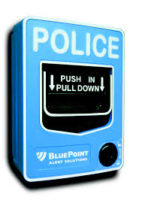A 911 communications center serves as the heart of police, fire, paramedic and other public services. Even in smaller municipalities emergency calls can arrive at a rate of one a minute. With lives literally on the line 24/7, there is no opportune time for these centers to fail due to a security breach.
Mike Flynn, director of the Spartanburg County (S.C.) 911 Communications Center, understands. The 22-year department veteran recently oversaw a review and update of the security systems protecting the downtown Spartanburg center.
“We wanted to make sure our security was up to current standards,” he said. “Too many people count on this center for us to do otherwise. We answer calls for 80 public safety agencies throughout the county, including the Spartanburg police, fire and EMS departments, the county sheriff, other county municipalities, fire departments and even seven college security/police forces.”
Flynn said the center’s 80 employees handle more than 750,000 calls annually. About 500,000 are for 911 services; the rest are non-emergency or outgoing calls. The 10,000-square-foot center is located on the third floor of a four-story building shared with local telephone carrier AT&T.
Anderson, S.C.-based Blue Ridge Security Solutions, the county’s integrator since 2009, was involved in the recent security upgrade. Tommy Bryan, Blue Ridge’s commercial sales representative, said the project included replacing several 20-year-old audio-only intercoms with IP-based IX series video intercoms from Aiphone Corp. The IX series is a network-based communication and security system featuring video entry security, internal communication, emergency stations and paging.
Most employees access the building through a fenced parking lot protected by a barrier gate connected to the facility’s access control system. Workers open the barrier using HID access cards and a reader attached to the gate’s base. An intercom, also mounted on the base, allows visitors and vendors to request access from a 911 center staff member. Center staff controls all building access.
The parking lot’s new video intercom, located about 500 feet from the building, required the installation of an NVT Ethernet converter to get IP performance over existing coax cable.
“For years, the gate was protected by an audio intercom and a surveillance camera,” Bryan said. “But we saw the benefits of the new video intercom and suggested it as a replacement. The new unit provides the same two-way conversation as well as real-time video. The center’s managers were impressed with the video quality.”
Once parked, employees and visitors proceed to the building’s locked rear door where they use their access control cards to unlock the entry. Visitors push the call button on a video intercom. From a master station in the center, staff can confirm the visitor is the same person from the gate and also see that unauthorized people don’t simultaneously enter.
AT&T employees are restricted to entering the building through the parking lot and rear entry. The building’s other entry, a street-level front door, is always kept locked. An outside access reader and video intercom accommodate the few people using this door. The same access combination is also mounted just outside the 911 center’s third-floor entry. One more video intercom is mounted outside the interior radio room, where calls for emergency assistance are answered and first responders are dispatched.
Bryan said there were two immediate benefits from the upgrade from audio to video intercoms.
“The audio-only system could support a limited number of answering stations, which the center had maxed out,” he said. “The IP-based video intercoms can handle a virtually unlimited number of stations, providing the center flexibility as its security needs change.”
Also, the video IP-based intercoms can be controlled remotely with the Aiphone mobile app for iOS and Android smartphones and tablets. “The app allows any compatible mobile device to be used as a sub master station,” Bryan said. “It enables authorized users to identify visitors, unlock doors and place or receive calls and pages to and from other system door and master stations. It also works on- or offsite.”
While the station’s intercoms had grown old, so, too, had the building’s access control system. Bryan said it had been years since it was last upgraded. Bringing it up-to-date would have cost thousands of dollars in manufacturer’s licensing fees. Also, it was the only county facility that deviated from the Spartanburg County standard. Blue Ridge Security was authorized to install a standard system from Galaxy Control Systems. The newly installed system also uses the county’s standard HID prox cards.
But the director, Flynn, had concerns about being part of the county network. “Due to the sensitive and vital nature of our work, we wanted the building on its own network to provide fewer points for potential hackers to penetrate,” he said.
Blue Ridge worked closely with the center to create the new network while not causing any disruption to employees or 911 services. That required technicians to work during hours the center was least busy. Also, several routers were tested to find the one best able to handle the new network demands and the uninterrupted transition.
Flynn said the upgrades have worked as intended. “These recent upgrades have made us feel more secure and confident in our ability to continue our vital mission,” he said. “And throughout the process, Blue Ridge has been a great partner.”







